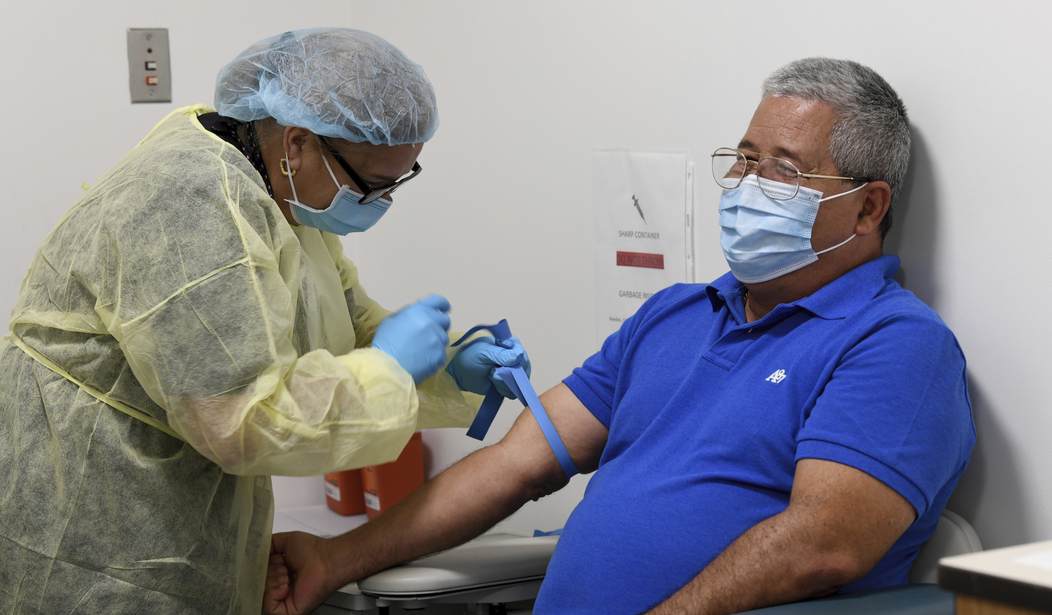Imagine how catastrophic the current Delta wave in the U.S. would be if more than 60 percent of the population didn’t already have vaccine antibodies when the variant arrived.
Now imagine how catastrophic it’ll be when it starts rolling through nations with low vaccination rates.
Nowhere is it written that India will be the only country to suffer the sort of Delta apocalypse that it endured this past spring.
Data from blood donations show Americans w/ COVID-19 antibodies increased from 20.5% to 83.3% after the rollout of #COVID19 vaccines. CDC is learning more about how many people need antibodies before the population can be considered protected. Learn more: https://t.co/YMdOt2DWjq pic.twitter.com/yYjEm8ta6Z
— CDC (@CDCgov) September 2, 2021
Looking at that graph raises an obvious question. If we’re at 83 percent with antibodies, shouldn’t we have reached herd immunity? How the hell are we still seeing giant waves in the American southeast, especially since the data above is current only through May? Lots more Americans have been either infected or vaccinated since then as Delta has burned through various states.
The problem is that as a virus becomes more contagious, the amount of population immunity needed to limit its spread rises. With the original SARS-CoV-2, scientists estimated 70-80 percent of the public would need antibodies before the spread abated. With Delta, that threshold may be 90 percent or more. The new variant is one of the most infectious respiratory diseases known to science.
But even 90 percent immunity might not crack the case since Delta is capable of infecting vaccinated people. That is, those who are “immune” aren’t truly immune. They’re largely immune from the sort of severe illness that might land them in the ER, but the variant can punch through vaccine immunity to cause mild disease. Once 90+ percent of us have antibodies, that might mean the end of surges in hospitalizations. But maybe not the end of waves of cases.
We also need to be careful about how much we extrapolate from this survey given its methodology. This wasn’t a random sample that might reasonably be expected to be representative of the entire U.S. population. It was an analysis of 1.4 million blood donations. To the extent that the population of voluntary blood donors differs demographically from the general population, the results here will distort the true degree of immunity across the United States. (The researchers did “weight” their sample by race, age, etc, to try to arrive at an estimate of immunity throughout the entire country.) One major way in which it differs is that, typically, only people 16 and over can donate blood. That means that while 83 percent of *adults* (and older teens) may have antibodies, the share of the total population that has them is almost certainly lower since kids under 12 can’t get vaccinated yet. Which leaves us even further away from herd immunity than we hoped.
That may help explain the surge in cases lately despite the high level of immunity among adults. Many of those positive tests are likely coming from children who are getting infected and then being tested as part of their school’s COVID protocols.
Another potential distorting factor in the study is that blood donors may be more likely than the average American to have antibodies. The researchers behind flagged that problem:
Fourth, vaccine-induced seroprevalence might be higher in blood donors than in the general population. For May 2021, among donations from donors with a known vaccine history, 73.3% were from donors who self-reported receiving a previous COVID-19 vaccine, compared with CDC estimates that 57.0% of US adults aged 18 years and older had received 1 dose or more of vaccine by May 2021. Blood donors are more likely than the general US population to be employed and have attended college,38 factors potentially associated with increased rates of vaccination and lower rates of infection.
People who are more “health-conscious,” let’s say, may be more likely to get vaccinated and to donate blood. If so then, again, the sample in the study may have more immunity on average than the U.S. population writ large does.
Finally, it’s unclear what effect waning immunity might have on estimates of how many Americans have antibodies at a given moment. If you had a mild case of COVID a year ago and generated a mild number of antibodies because of it, you may have had enough in your system for those antibodies to be detectable in a blood sample you gave this past spring. But what about now? Can population immunity shrink over time?
Even if it can, it’s probably not shrinking now. Because this study wrapped up in May, it missed virtually all of the infections caused by the rise of Delta in the U.S. this summer. That’s millions more people who have gained immunity the hard way. And there are millions who have gained it the not-so-hard way over that period as well:

Eventually so many of us will have either had their shots or had the virus that hospitalizations will slow down and never really start up again (barring a new variant emerging). But we’re not there yet.
One more interesting data point from the study:
The data in this study suggest that for every COVID-19 case reported, the number of people infected and with detectable SARS-CoV-2 antibodies decreased from 3.1 in July 2020 to 2.1 in May 2021. A previous blood donor seroprevalence study reported a similarly decreasing ratio from March through August 2020 for 6 regions. Increases in testing supplies, access to testing, and serial testing programs at universities, long-term care facilities, and other locations may have contributed to increased case detection and reporting, but waning of antibodies may also be contributing.
That question has been debated since the start of the pandemic. We know how many confirmed cases there are, but how many actual infections are happening yet never being recorded because the infected person never gets tested? The study says the ratio used to be three to one but has now dropped to two to one, probably for the simple reason that testing has gotten more accessible over time. Some infections that would have been missed a year ago are getting picked up now because it’s easy enough for someone who’s sick to go to CVS or Walgreens to get swabbed.
I’ll leave you with Scott Gottlieb predicting the end of the pandemic. Sort of.
"We're going to go back to normal after this delta wave. Hopefully this is the last real wave of infection we're going to experience. But it's going to be a new normal because this is going to become an endemic virus. It's going to circulate every year," says @ScottGottliebMD. pic.twitter.com/Jwo9Ykt0DL
— Squawk Box (@SquawkCNBC) September 3, 2021







Join the conversation as a VIP Member